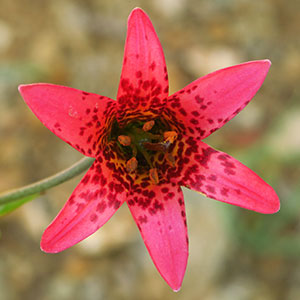Lilium bolanderi
Lilium superbum
Bolander's lily
Turk's-cap lily
± ovoid, 3.5–7.9 × 2.6–5.3 cm, 0.9–2.1 times taller than long;
scales unsegmented, longest 3–5.7 cm;
stem roots absent.
rhizomatous, often branching dichotomously at 120° from main axis, 2.4–4.3 × 6–10.2 cm, 0.2–0.6 times taller than long, 2(–3) years’ growth evident as annual bulbs, the scaleless sections between these 0.6–3.8(–4.6) cm;
scales 1–2-segmented (if 2-segmented, often only on inner scales), longest 1.2–3.9 cm;
stem roots present or absent.
to 1.1 m, glaucous.
1.2–2.8 m. Buds ± triangular in cross section.
rounded in cross section.
in 1–5(–6) whorls or partial whorls, 3–19 leaves per whorl, ascending and often cupping stem, 1.8–7.1 × 0.7–2.8 cm, 2.2–4.8 times longer than wide;
blade ± obovate, oblanceolate, or occasionally elliptic, noticeably glaucous, margins nearly always undulate, apex widely acute;
veins and margins ± smooth abaxially.
usually ± evenly distributed along stem, in 6–24 whorls or partial whorls, 3–20 leaves per whorl, usually ± horizontal and drooping at tips, distal leaves ascending in sun, 7.1–26.1 × 0.7–2.7 cm, 4–18 times longer than wide;
blade narrowly elliptic, sometimes extremely so, occasionally barely oblanceolate, margins not undulate, apex acute, acuminate in distal leaves;
veins and margins ± smooth abaxially.
usually umbellate in small plants, in large plants racemose or in 2 whorls, 1–9-flowered.
racemose, 1–22-flowered.
nodding to horizontal, not fragrant;
perianth ± campanulate or funnelform;
sepals and petals somewhat recurved 3/5–4/5 along length from base, red or magenta, occasionally salmon pink or pale yellow, with maroon spots, often yellowish on proximal 1/3–1/2, not distinctly clawed;
sepals not ridged abaxially, 3.1–4.7 × 0.7–1.2 cm;
petals 3–4.5 × 0.7–1.1 cm;
stamens included;
filaments barely spreading, diverging 0°–12° from axis;
anthers reddish or magenta, 0.3–0.8 cm;
pollen rust, orange, or yellow;
pistil 2.1–3.5 cm;
ovary 1–2.1 cm;
style green, rarely reddish purple;
pedicel 0.8–14.2 cm.
pendent, not fragrant;
perianth Turk’s-cap-shaped;
sepals and petals reflexed less than 1/5 along length from base, yellow or sometimes yellow-orange proximally, red-orange or sometimes red, red-purple, orange, or yellow barely suffused with red distally, spotted magenta, not distinctly clawed, nectaries exposed, forming visible green star;
sepals with 2 parallel, often faint abaxial ridges, 6.8–10.5 × 1.1–2.1 cm;
petals 7–10.2 × 1.4–2.6 cm;
stamens strongly exserted;
filaments parallel along much or most of length, then widely spreading, diverging (7°–)11°–30° from axis;
anthers magenta, occasionally purple or dull purple, 1.4–2.6 cm;
pollen rust;
pistil 4.7–8.2 cm;
ovary 1.5–3.4 cm;
style pale green, often spotted purple;
pedicel 7.4–19.1 cm.
2–4.1 × 1.2–2.1 cm, 1.4–3 times longer than wide.
2.9–6.2 × 1.7–2.5 cm, 1.7–3.3 times longer than wide.
90–210.
not counted.
= 24.
= 24.
Lilium bolanderi
Lilium superbum
I. M. Johnston (1923) noted that Lilium bolanderi Watson was based on a mixed collection including L. kelloggii, and he argued that Watson intended the name to apply primarily to the latter species. Thus he proposed the name L. howellii for this diminutive, red-flowered, serpentine endemic. A. D. Cotton (1936) correctly concluded that Watson’s description applied primarily to the specimens here called L. bolanderi, and this view is now widely accepted.
Lilium bolanderi hybridizes with L. rubescens, L. washingtonianum subsp. purpurascens, and subspecies of L. pardalinum.
Bolander’s lily is primarily pollinated by Allen’s and rufous hummingbirds (Selasphorus spp., family Trochilidae).
(Discussion copyrighted by Flora of North America; reprinted with permission.)
The largest Lilium east of the Rocky Mountains and the commonest over most of its range, the Turk’s-cap lily is a familiar sight throughout much of the southern Appalachians and along the northern Atlantic coastal plain. Flowers are rather variable; those in the north are sometimes floridly colored with dark purple bases on the perianth parts. The single report from Vermont (F. C. Seymour 1993) remains unconfirmed; however, recent collections from Washington Parish in Louisiana, Perry County in Missouri, and Bamberg County in the coastal plain of South Carolina extend the range of this species.
Lilium superbum shares distinctive features with L. michauxii, L. pyrophilum, and L. iridollae that indicate a close relationship and are diagnostically useful, namely paired ridges on the backs of the sepals and buds that are triangular in cross section. None has the red style characteristic of the other eastern pendent lily clade (L. michiganense, L. canadense, and L. grayi) centered to the northwest, and only L. iridollae sometimes has the leaf margins and veins roughened abaxially as is characteristic of L. canadense and its close relatives.
Common inheritance of a suite of unique, derived features and peripheral allopatric distributions suggest that Lilium pyrophilum and L. iridollae may be geographical isolates of broadly distributed L. superbum ancestral stock; both restricted species occur in specialized wetland habitats. Geography aside, the three are unequivocally distinguished only by various combinations of leaf and bulb characteristics, flower color, habitat, and blooming time. However, the overall degree of separation is comparable to that between many other species in the genus. Lilium superbum blooms the earliest, is the largest, and has the most numerous and largest flowers, and the long, narrow leaves in many whorls are distinctive. Lilium michauxii overlaps in range with these three species but is easily separated morphologically and ecologically.
Lilium superbum is pollinated primarily by the swallowtail butterflies that are common within its range, among them the spicebush (Papilio troilus Linnaeus, family Papilionidae), pipevine (Battus philenor Linnaeus), and eastern tiger (Papilio glaucus Linnaeus). Great spangled fritillaries [Speyeria cybele (Fabricius), family Nymphalidae] also visit the Turk’s-cap lily (R. M. Adams and W. J. Dress 1982).
(Discussion copyrighted by Flora of North America; reprinted with permission.)


